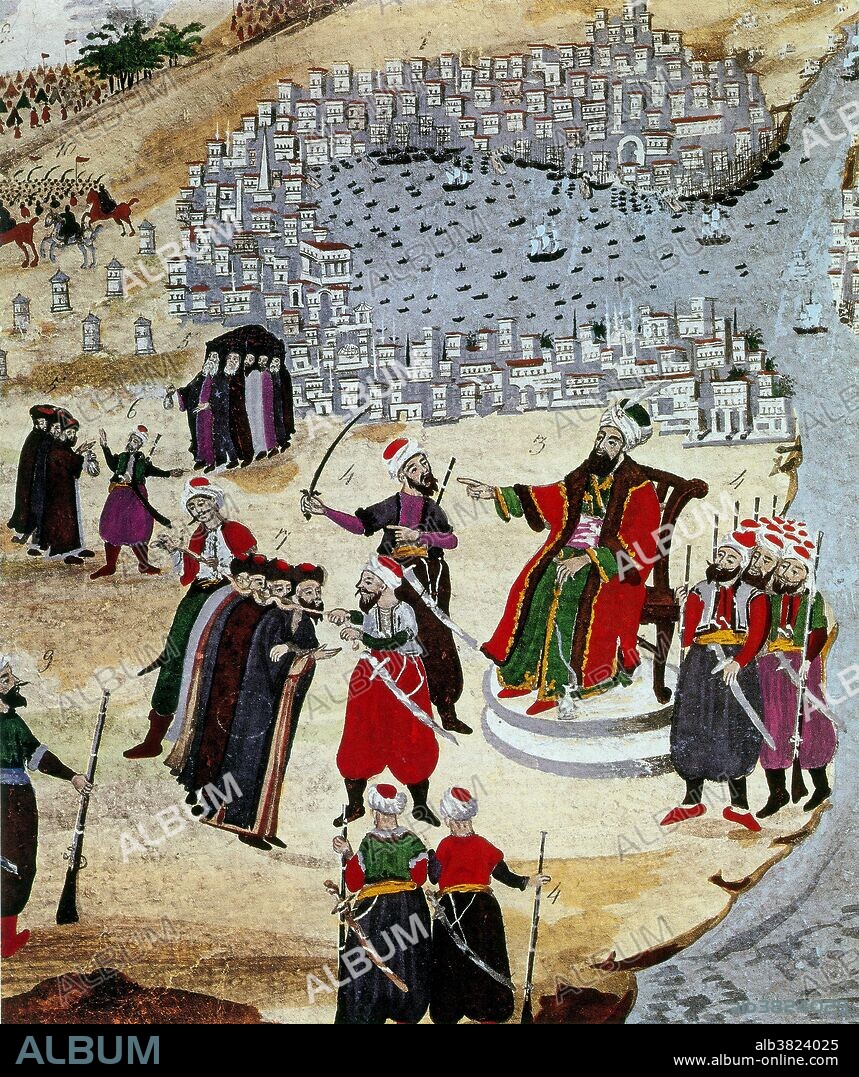alb3824025
Fall of Constantinople, Ottoman Sultan Mehmed II, 1453

|
Ajouter à une autre Lightbox |
|
Ajouter à une autre Lightbox |



Avez-vous déjà un compte? S'identifier
Vous n'avez pas de compte ? S'inscrire
Acheter cette image.
Sélectionnez l'usage:

Titre:
Fall of Constantinople, Ottoman Sultan Mehmed II, 1453
Légende:
Traduction automatique: Détail de la Chute de Constantinople, 1453 peint par Panagiotis Zografo. Constantinople était la capitale de l?Empire romain d?Orient, des empires latin et ottoman. Elle a été fondée en 330 après JC, dans l'ancienne Byzance, comme nouvelle capitale de l'Empire romain par Constantin Ier. La ville était la ville européenne la plus grande et la plus riche du Moyen Âge. Un mur intérieur fut érigé par Constantin Ier et la ville était entourée d'un triple mur de fortifications, commencé au Ve siècle par Théodose II. La ville était construite sur sept collines ainsi que sur le Bosphore et présentait ainsi une forteresse imprenable renfermant de magnifiques palais, dômes et tours. L'église de Sainte-Sophie, le palais sacré des empereurs, l'Hippodrome et la Porte Dorée comptaient parmi les plus grandes des nombreuses églises, édifices publics et monuments bordant les avenues et les places à arcades. Bien qu'assiégée à de nombreuses reprises par divers peuples, elle ne fut prise qu'en 1204 par l'armée de la Quatrième Croisade, en 1261 par Michel VIII et en 1453 par le sultan ottoman Mehmed II. Les sultans ottomans ont embelli Constantinople avec de nombreuses belles mosquées, palais, monuments, fontaines, bains, aqueducs et autres bâtiments publics.
Detail from Fall of Constantinople, 1453 painted by Panagiotis Zografo. Constantinople was the capital of the Eastern Roman Empire, the Latin and the Ottoman Empires. It was founded in AD 330, at ancient Byzantium as the new capital of the Roman Empire by Constantine I. The city was the largest and wealthiest European city of the Middle Ages. An inner wall was erected by Constantine I, and the city was surrounded by a triple wall of fortifications, begun during the 5th century by Theodosius II. The city was built on seven hills as well as on the Bosporus, and thus presented an impregnable fortress enclosing magnificent palaces, domes and towers. The Church of Hagia Sophia, the sacred palace of the emperors, the Hippodrome, and the Golden Gate were among the largest of the many churches, public edifices, and monuments lining the arcaded avenues and squares. Although besieged on numerous occasions by various peoples, it was taken only in 1204 by the army of the Fourth Crusade, in 1261 by Michael VIII, and in 1453 by the Ottoman Sultan Mehmed II. The Ottoman sultans embellished Constantinople with many beautiful mosques, palaces, monuments, fountains, baths, aqueducts and other public buildings.
Crédit:
Album / Science Source / New York Public Library
Autorisations:
Taille de l'image:
3153 x 3759 px | 33.9 MB
Taille d'impression:
26.7 x 31.8 cm | 10.5 x 12.5 in (300 dpi)
Mots clés:
CÉLÈBRE • CELEBRITE • EMPIRE BYZANTIN • ÉVÉNEMENT • HOMME • ISTANBUL • PERSONNAGES • PERSONNALITÉS • PERSONNE
 Pinterest
Pinterest Twitter
Twitter Facebook
Facebook Copier le lien
Copier le lien Email
Email
